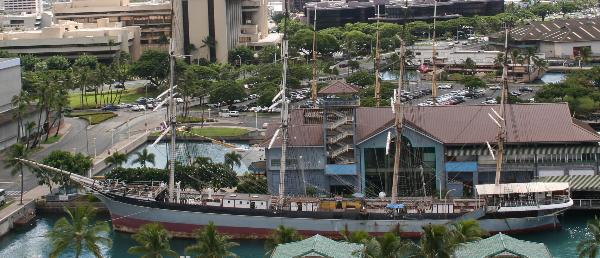The Falls of Clyde Traditional Geocache
Crow T Robot: Please contact me if this one is resolved. Thanks.
-
Difficulty:
-

-
Terrain:
-

Size:  (micro)
(micro)
Please note Use of geocaching.com services is subject to the terms and conditions
in our disclaimer.
Wiki Cache Information:
Parking: Park at Aloha Tower. It is $2 with validation of any
purchase from area shops or museum admission.
Total Distance Traveled: Half mile from parking.
Estimated amount of time to complete: Less than one hour.
Amenities: Restroom can be found upstairs above Hooters or in the
Museum.

The Falls of Clyde is distinguished as the only surviving
iron-hulled sail-driven vessel in the world. The hull is a hollow
tank with an 800 gallon capacity that was used to transport oil and
molasses among other things.
If The Falls of Clyde were an automobile in her younger years, she
would be a heavy duty pick-up truck and among one of the fastest
cars on the open road. Although she was tasked with some pretty odd
jobs like the transport of brides to Austrailia from England (this
earned her the nick-name The Brides Ship) and languishing as a
floating storage tanker/hotel off the coast of Alaska for almost 30
years, most of her working days were spent hauling cargo around the
world.
Here's a brief outline of the incredible international odyssey
of this vessel:
1878- Built by Russell and Company in Port Glasgow, Invercycle,
Scotland. She was built to the highest standard for worldwide trade
- Lloyd's Register A-1. Her maiden voyage took her to Karachi, now
in Pakistan. She spend first six years in the India trade.
1884- 1899. Became a tramp pursuing general cargo such as lumber,
jute, cement, and wheat from ports in Australia, California, India,
New Zealand, and the British Isles.
1899-1907. Purchased for US $25,000 by Captain William Matson of
the Matson Navigation Company, taken to Honolulu, Hawaii and
registered under the Hawaiian flag. To economize on crew Matson
rigged her as a barque, with two more easily managed fore-and-aft
sails. The ship made over 60 voyages between Hilo, Hawaii, and San
Francisco, California. She carried general merchandise from San
Francisco and sugar from Hawaii, and passengers both ways. Her
voyages averaged 17 days each way.
1907-1927. The Associated Oil Company bought Falls of Clyde and
converted her to a bulk tanker with a capacity of 19,000 barrels
(three million liters, 800,000 gallons). On her return voyages, she
carried bulk molasses to California, where it was used for cattle
feed.
1927-1959. The ship was sold to the General Petroleum Company, who
cut her masts down, and she served as a floating fuel depot in
Alaska.
1959-1963. She was sold to William Mitchell, who towed her to
Seattle, Washington, intending to sell her to a preservation group.
Mitchell's plan fell through and subsequent efforts by Karl Kortum,
director of the San Francisco Maritime Museum, and Fred Klebingat,
who had sailed in her as chief mate in 1915, to place her in Long
Beach, California, or Los Angeles, California, were similarly
disappointed.
1963. The bank holding the mortgage on Falls of Clyde decided to
sell her to be sunk as part of a breakwater at Vancouver, British
Columbia. Kortum and Klebingat aroused interest in the ship in
Hawaii, and within days of the scheduled scuttling, raised funds to
buy the ship. Most of the funds raised were donated by island
residents.
1964. Falls of Clyde was given to the Bishop Museum. She opened to
the public in 1968. Her restoration as a full-rigged ship was
assisted by the grandson of the original 19th century designer,
William Lithgow.
1973. She was entered into the National Register of Historic
Places and located where it can be found today at Pier 7, Honolulu
Harbor, part of the Hawaii Maritime Center
2006. Team Geoblast places a micro cache near the ship so all
geocachers have another reason to visit and enjoy the history of
this fine vessel.
Spring 2008. The Bishop Museum announces that they cannot bear the
cost of insurance and upkeep of the ship any longer. The masts are
removed and a plan to scuttle the ship 15 miles off the coast of
Honolulu is revealed. This plan was aggressively backed by local
dive companies as they saw the potential for a new dive tour
destination.
Fall 2008. Just as Kortum and Klebingat did in 1963, a local
community group rallies with a
plan to once again rescue the ship from being sunk.
Spring 2009. The Falls of Clyde's future is now officially
"uncertain" as the Maritime Musuem is closing. Team GeoBlast
changes hide again to keep things interesting.
Additional Hints
(Decrypt)
Vg'f abg va gur jngre. Ohg vg'f arne fbzrguvat gung cebonoyl oyrj n srj guvatf bhg bs gur jngre.